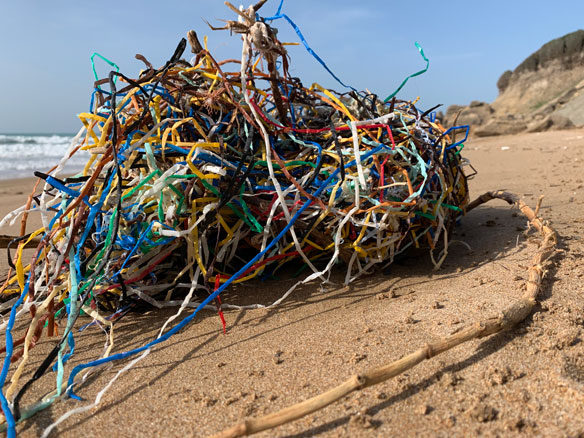
“The unprecedented plastic waste tide plaguing our oceans and shores, can become as limited as our chosen relationship with plastics, which involves a dramatic behavioral change on our part…”
Captions and Photo: © SAF — Coastal Care
Excerpts;
The global fashion industry generates a huge amount of waste – one full garbage truck of clothes is burned or sent to a landfill every second, according to a report by the Ellen MacArthur Foundation, a leading non-profit working to improve the industry’s sustainability record.
“60% of materials used by the industry are plastic fibers [and] the equivalent of 50 billion plastic bottles are leaked into the ocean through garment wash every year…”
Read Full Article, CNN (05-03-2020)
Putting the brakes on fast fashion; UNEP (11-12-2018)
Every second, the equivalent of one garbage truck of textiles is landfilled or burned. If nothing changes, by 2050 the fashion industry will use up a quarter of the world’s carbon budget. Washing clothes also releases half a million tonnes of microfibres into the ocean every year..
Scientists find highest ever level of microplastics on seafloor; PhysOrg (04-30-2020)
An international research project has revealed the highest levels of microplastic ever recorded on the seafloor, with up to 1.9 million pieces in a thin layer covering just 1 square meter.Microplastics on the seafloor are mainly comprised of fibres from textiles and clothing…
Stars urged to ditch the sequins at the Oscars to save the oceans; The Guardian UK (02-07-2020)
How plastic waste moves in the environment; Science Daily (11-27-2018)
A researcher for the first time has modeled how microplastic fibers move through the environment…
Sea anemones are ingesting plastic microfibers; Science Daily (03-28-2019)
Video captures moment plastic enters food chain, BBC News (03-11-2017)
A scientist has filmed the moment plastic microfibre is ingested by plankton, illustrating how the material is affecting life beneath the waves. The footage shows one way that plastic waste could be entering the marine and global food chain…
Plastic Pollution: When The Mermaids Cry, The Great Plastic Tide, Coastal Care
Washed out on our coasts in obvious and clearly visible form, the plastic pollution spectacle blatantly unveiling on our beaches is only the prelude of the greater story that unfolded further away in the world’s oceans, yet mostly originating from where we stand: the land…
Bangladesh Pollution, Told in Colors and Smells; The New York Times (07-21-2013)
Bangladesh’s garment and textile industries have contributed heavily to what experts describe as a water pollution disaster. Environmental damage usually trails rapid industrialization in developing countries, and Bangladesh is already one of the world’s most environmentally fragile places, densely populated yet braided by river systems, with a labyrinth of low-lying wetlands leading to the Bay of Bengal…
Toxic Threads: Polluting Paradise A story of big brands and water pollution in Indonesia, by Greenpeace (04-28-2013)
Greenpeace International investigations have revealed the dumping of industrial wastewater containing a cocktail of toxic and hazardous chemicals, and caustic water, directly into the Citarum River, West Java. International fashion brands are linked to this pollution…
Dirty Laundry: Greenpeace Reports on Toxic Industrial Water Pollution, by Greenpeace (08-26-2011)
A report released by Greenpeace International, after a year-long study research into industrial water pollution, reveals the presence of hazardous chemicals in clothing items bearing the logos of 14 global popular brands, linking many of the same clothing brands to suppliers in China who were found to be releasing daily cocktail of chemicals into the Pearl River and Yangtze River deltas, discharging into the China Sea…









